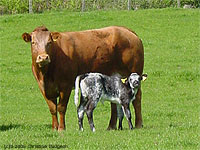A Simple Herd Check For Johne’s
19 December 2016Johne’s is an increasing concern with many pedigree breeders striving to reach Risk Level 1.
Reduced performance and in particular sale value of cull animals will be just as critical for commercial breeders so it is important they know the Johne’s status of their herd. Dairy producers have been able to monitor the Johne’s status of their herd by taking a single sample of milk out of the bulk tank, beef producers have had to take blood samples from all breeding females over 2 years of age. There are cheaper ways to give a clear assessment of whether Johne’s disease is present in the herd before deciding on the need for whole herd testing.
Sampling Cull Cows
Cull cows are likely to include a higher proportion of infected animals in herds infected with Johne’s. Blood sampling all cull animals each year will therefore give a good indication of whether Johne’s disease is a herd problem –
- If none of the annual cull animals test positive there is a high chance the herd is free of Johne’s. .
- If just one cow is tested positive then the herd is infected. The higher the proportion of culls which test positive then the higher the proportion of cows in the herd which are likely to be carrying the disease. Discussion with your vet on second or further sampling would be the next step.
This approach does require discipline of blood sampling all cull cows ie just after weaning when they are grouped for sale.
Sampling Slurry
Dairy herds have used a system of taking a representative sample of the slurry from the herd and using it to test for Johne’s. The important points are to ensure the slurry is as well mixed as possible eg sampling when the slurry is scraped out by either an automatic scraper of by a tractor. The other point is to get a sample from all cows in the herd. With dry dairy cows being bedded on straw prior to calving dairy producers have overcome this problem by taking samples 3 or 4 times a year so that every cow will be included in at least one of the tests.
The system is suited to cubicles and straw bedded yards which have a scraped feed passage. Again it is important to ensure the sample contains slurry from all cows in the herd.
In fully slatted sheds it is unlikely that dung collected from the solid end sections of the slats will be representative of all cows in the pen. An alternative would be to take samples when the cellars are being emptied with perhaps half a dozen samples being collected and then mixed together before being sent off. (NB Care must be taken to avoid slurry gas. Only take samples when someone is with you.)
Chat to your vet to determine which approach would be best for you. Remember that the Johne’s status of the herd is becoming increasingly important in the marketing of stock, particularly breeding stock.
Sign up to the FAS newsletter
Receive updates on news, events and publications from Scotland’s Farm Advisory Service

